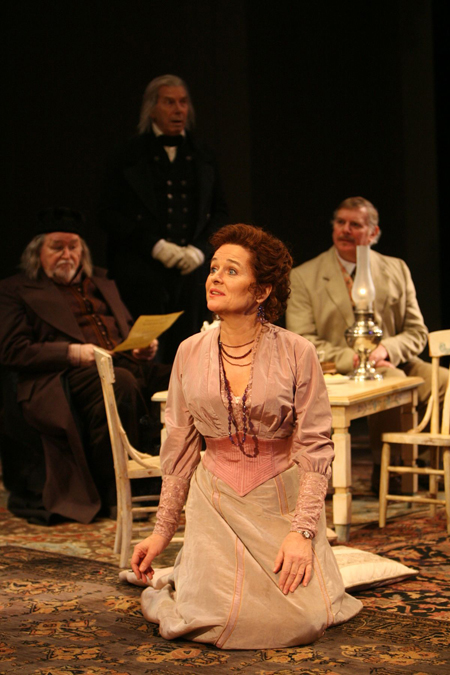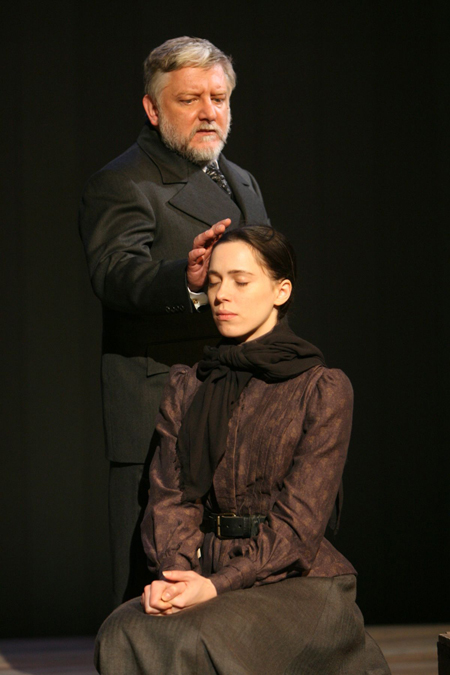 |
Chekhov’s The Cherry Orchard, in a literate and humorous new version by Tom Stoppard, is currently playing at the Brooklyn Academy of Music (BAM) in New York City. Directed by Sam Mendes, the production brings together a wealth of British and American actors in a warm and invigorating production.
The production is the first for The Bridge Project, a joint effort between BAM and The Old Vic Theatre in London. The Bridge Project was created to foster better collaboration between British and American actors and audiences, and for the next three years will produce two classic plays each year with a repertory cast of British and American actors. The home theaters will be BAM and the Old Vic, with additional performances in other countries. All of the productions will be directed by Sam Mendes, who inspired The Bridge Project by directing a British/American cast in repertory productions of Uncle Vanya and Twelfth Night in 2002 at BAM and Donmar Warehouse (London).
From the opening scenes of the play, Anthony Ward’s disembodied set design evoked the proper mood of a house, a community, an era in flux and already slipping out of the grasp of those who want to cling to it most. There is still some ambient warmth in the overlapping oriental rugs or the candles in the ballroom scene, but everything feels transitory and fleeting, with much of the energy and music of the ballroom scene, for example, happening off-stage.
Sam Mendes’ direction moves the play along well, lingering over certain moments in the greetings and farewells without overdoing them. But there were several jarring direction choices that felt heavy-handed and out of place, such as the threatening peasants lining the stage at the beginning of Act II or some of the mood music that seemed to be trying to strengthen the tension but ended up distracting from the action on stage.
 |
Chekhov had very specific ideas about the ways in which emotion should be written and acted in plays. In letters to various directors and actors he laid these out:
In the sphere of psychology, details are also the thing. God preserve us from commonplaces. Best of all is it to avoid depicting the hero’s state of mind; you ought to try to make it clear from the hero’s actions.” And then, “The immense majority of people are nervous, you know: the greater number suffer, and a small proportion feel acute pain; but where—in streets and in houses—do you see people tearing about, leaping up, and clutching at their heads? Suffering ought to be expressed as it is expressed in life—that is, not by the arms and legs, but by the tone and expressions; not by gesticulation, but by grace. Subtle emotions of the soul in educated people must be subtly expressed in an external way.
The characters of Lopakhin and Ranevskaya are both wonderful examples of Chekhov’s mastery of the expression of complex states of mind through actions rather than commonplace depictions. Even though both characters have short monologues that hint at pieces of their pasts, their actions and abbreviated conversations speak most richly to their conflicted emotions. Perhaps the writing resonated most clearly with these two characters because Simon Russell Beale and Sinéad Cusack act with such understanding and nuance. Even without words, Beale’s posture and physical energy on stage differentiate him from the nobility he admires and despises at the same time. The tortured timing of his final scene with Varya is both revelatory and heartbreaking. Cusack’s Ranevskaya, swooping between despair and gaiety, paints a picture of a woman always led by her heart but denying its pitfalls.
 |
Ethan Hawke, while certainly not the only American in the cast, seems more noticeably so by a certain brashness and eager energy in his interpretation of the chronic student Trofimov, who idealizes social revolution. It plays well at first in contrast to the more nuanced and jaded aristocracy (played by both British and American actors), but in the end lacks some of the subtlety sought by Chekhov.
Chekhov described the difference between those artists who see something beyond themselves and those who cannot in this letter to a good friend and critic:
Bear in mind that writers who are considered immortal or just plain good and who intoxicate us have one very important trait in common: they are going somewhere and call you with them; you sense, not with your mind but with all your being, that they have an aim, like the ghost of Hamlet’s father, who had a reasons for appearing and alarming the imagination. Looking at some of them in terms of their caliber you will see that they have immediate aims—the abolition of serfdom, the liberation of their country, political matters, beauty, or just vodka . . .; others have remote aims—God, life beyond the grave, the happiness of mankind and so on. The best of them are realistic and paint life as it is, but because every line is saturated with juice, with the sense of life, you feel, in addition to life as it is, life as it should be, and you are entranced. Now what about us? Yes, us! We paint life such as it is—that’s all, there isn’t any more . . . Beat us up, if you like, but that’s as far as we’ll go. We have neither immediate nor distant aims, and you can rattle around in our souls.
Chekhov believed life could be meaningful, but that meaning was only to be found in the noble idealistic struggle against humanity’s ultimate tragic end, which is non-existence. There is always a sense of hopelessness underlying his words, but at the same time he paints humanity so truly and with such a loving and specific eye that one cannot help but be drawn to these people. This production gives life to that vision, both hopeless and loving.

